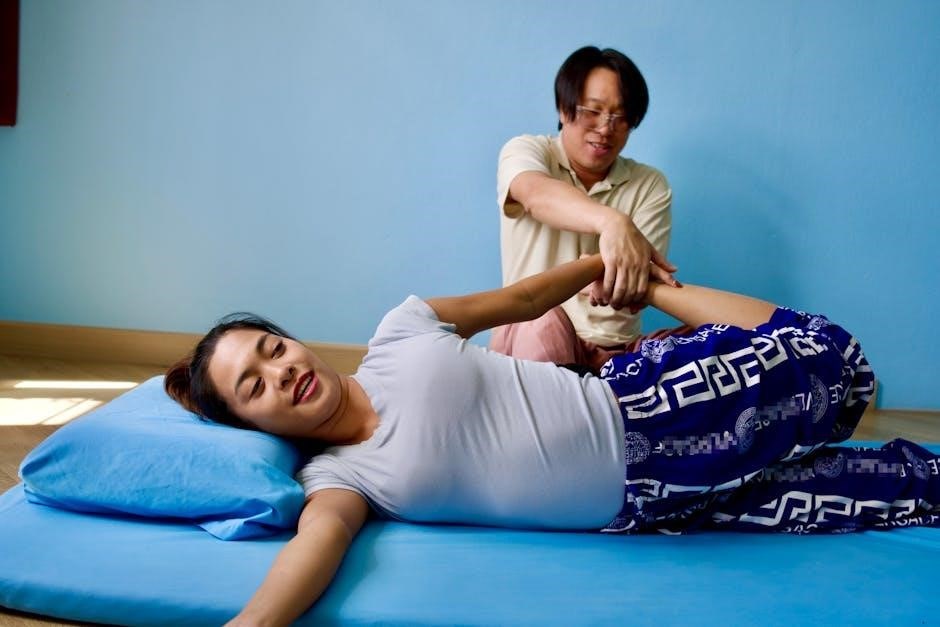What is an Integrated Manual Therapist?
Integrated Manual Therapists utilize a holistic approach, blending various techniques to address musculoskeletal issues and improve overall functionality, aiding breathing and mobility.
Defining Integrated Manual Therapy
Integrated Manual Therapy (IMT) represents a comprehensive and individualized approach to healthcare, moving beyond isolated symptom treatment. It’s a specialized field where therapists assess and address the interconnectedness of the body’s systems – musculoskeletal, visceral, neurological, and emotional.
Unlike solely focusing on a painful area, IMT seeks to identify the root cause of dysfunction, often located elsewhere in the body. This involves skilled hands-on techniques to release restrictions in tissues, restore proper joint mechanics, and improve overall movement patterns. The goal isn’t just pain relief, but restoring optimal function and promoting the body’s innate healing capabilities.
The Holistic Approach
Integrated Manual Therapy champions a truly holistic perspective, recognizing the body as an interconnected web rather than separate parts. This means considering not only physical symptoms, but also the influence of emotional stress, lifestyle factors, and sensory processing.
Therapists delve into how past injuries, habitual postures, and even breathing patterns contribute to current dysfunction. Gestalt therapy principles, emphasizing present moment awareness, can be incorporated. IMT acknowledges the mind-body connection, aiming to address the whole person – fostering not just physical healing, but also improved body awareness and overall well-being.

Core Techniques Used by Integrated Manual Therapists
Integrated Manual Therapists skillfully employ myofascial release, muscle energy techniques, joint mobilization, and visceral manipulation to restore optimal body function and ease pain.
Myofascial Release
Myofascial Release is a gentle, yet effective, technique addressing restrictions within the fascia – the connective tissue network surrounding muscles. Integrated Manual Therapists apply sustained pressure to release tightness, restoring mobility and reducing pain. This method targets chronic muscle tension, improving posture and movement patterns.
By releasing fascial restrictions, therapists aim to eliminate pain signals and enhance overall bodily function. It’s a holistic approach, recognizing the interconnectedness of the body’s systems. This technique is often utilized for musculoskeletal conditions, promoting flexibility and a sense of well-being, ultimately improving quality of life.
Muscle Energy Techniques
Muscle Energy Techniques (MET) involve gentle muscle contractions against a counterforce applied by the Integrated Manual Therapist. This collaborative approach aims to restore optimal joint motion and muscle length. MET utilizes the patient’s own muscle energy to correct imbalances, enhancing range of motion and reducing pain.
The therapist guides the patient through specific contractions, facilitating a release of restricted tissues. It’s a dynamic technique, promoting neuromuscular re-education and improved biomechanics. MET is particularly effective for addressing joint restrictions and muscle spasms, leading to improved function and reduced discomfort.
Joint Mobilization
Joint Mobilization, a core technique employed by Integrated Manual Therapists, focuses on restoring proper joint mechanics. This involves skilled hand movements applied to specific joints to address restrictions in movement and reduce pain. Therapists utilize graded oscillations and sustained pressures to improve joint play – the small, passive movements within a joint.
The goal isn’t to force movement, but to restore the natural gliding and sliding motions. This technique enhances joint health, reduces muscle guarding, and improves overall function. It’s a gentle yet effective method for addressing joint stiffness and discomfort, promoting optimal biomechanics.
Visceral Manipulation
Visceral Manipulation, a specialized technique within Integrated Manual Therapy, addresses restrictions within the visceral system – the organs and their surrounding tissues. Therapists gently apply manual forces to encourage the natural mobility of these structures, releasing tension and restoring optimal function.
This approach recognizes the interconnectedness of the body, acknowledging that restrictions in the viscera can contribute to musculoskeletal pain and dysfunction. By releasing these restrictions, therapists aim to improve organ function, reduce pain, and enhance overall health. It’s a subtle yet powerful technique for addressing deep-seated imbalances.

Conditions Commonly Treated
Integrated Manual Therapy effectively addresses musculoskeletal pain, TMJ disorders, postural imbalances, headaches, and even respiratory difficulties like those experienced with COVID-19.

Musculoskeletal Pain (Back, Neck, Shoulders)
Integrated Manual Therapy excels in treating musculoskeletal pain affecting the back, neck, and shoulders. Therapists pinpoint and address the root causes of discomfort, utilizing techniques like myofascial release and joint mobilization. These methods restore proper movement patterns and reduce muscle tension, offering lasting relief.
By addressing restrictions in the fascia and joints, therapists alleviate pain and improve functionality. This holistic approach considers the interconnectedness of the body, ensuring comprehensive care. Manual therapy can be particularly beneficial for individuals experiencing chronic pain or recovering from injuries, promoting improved mobility and a better quality of life.
Temporomandibular Joint (TMJ) Disorders
Integrated Manual Therapists effectively address Temporomandibular Joint (TMJ) disorders through specialized techniques. They focus on releasing tension in the jaw muscles, surrounding fascia, and neck structures, restoring proper joint mechanics. This approach alleviates pain, clicking, popping, and limited jaw movement often associated with TMJ dysfunction.
Treatment involves gentle yet precise manual interventions, aiming to rebalance the muscles and ligaments supporting the jaw. Therapists also consider postural imbalances and stress factors contributing to the condition. By addressing the underlying causes, Integrated Manual Therapy provides long-term relief and improved jaw function, enhancing overall comfort and quality of life.
Postural Imbalances
Integrated Manual Therapists expertly address postural imbalances, recognizing their impact on overall musculoskeletal health. They assess and correct misalignments in the spine, pelvis, and extremities, restoring optimal body mechanics. Through targeted manual techniques, therapists release tight muscles and fascia, lengthening shortened tissues and strengthening weakened ones.
This holistic approach improves posture, reduces strain on joints, and enhances movement efficiency. Therapists also educate patients on proper body mechanics and ergonomic principles, empowering them to maintain postural improvements. Addressing postural imbalances alleviates pain, prevents future injuries, and promotes a more balanced and functional body.
Headaches and Migraines
Integrated Manual Therapists offer effective treatment for headaches and migraines by addressing underlying musculoskeletal dysfunctions. They focus on releasing tension in the neck, shoulders, and scalp, areas commonly contributing to headache pain. Techniques like myofascial release and joint mobilization restore proper movement and reduce muscle spasms.
Furthermore, therapists assess and correct postural imbalances that can exacerbate headaches. By addressing the root causes, rather than just masking symptoms, they provide lasting relief. Patients often experience reduced frequency, intensity, and duration of headaches, improving their quality of life significantly.

The Benefits of Integrated Manual Therapy
Integrated Manual Therapy enhances body awareness, reduces pain, improves range of motion, and provides stress relief, fostering overall well-being and functional mobility.
Improved Range of Motion
Integrated Manual Therapy directly addresses restrictions in joint capsules, muscle tissues, and fascial systems, leading to noticeable improvements in a patient’s range of motion. Therapists skillfully employ techniques like myofascial release and joint mobilization to restore optimal movement patterns.
This isn’t simply about flexibility; it’s about regaining the ability to perform daily activities with greater ease and efficiency. Increased range of motion reduces compensatory movements, preventing secondary pain and promoting healthier biomechanics. Ultimately, patients experience enhanced physical function and a better quality of life through restored mobility.
Pain Reduction
Integrated Manual Therapy excels at alleviating pain by targeting the root causes, not just the symptoms. Techniques like muscle energy and visceral manipulation release tension, reduce inflammation, and restore proper biomechanics. This holistic approach effectively addresses musculoskeletal pain, headaches, and even discomfort related to breathing difficulties.
By restoring optimal tissue function and nervous system regulation, the therapy diminishes pain signals and promotes the body’s natural healing processes. Patients often experience significant and lasting pain relief, allowing them to return to activities they enjoy with greater comfort and ease.
Enhanced Body Awareness
Integrated Manual Therapy fosters a deeper connection between mind and body, cultivating heightened proprioception – the sense of self-movement and body position. Through gentle, focused techniques, patients become more attuned to subtle tension patterns, postural imbalances, and restricted movement.
This increased awareness empowers individuals to actively participate in their healing process, making conscious adjustments to improve posture, movement quality, and overall body mechanics. Ultimately, enhanced body awareness promotes self-regulation, preventing future discomfort and fostering a sense of embodied well-being.
Stress and Tension Relief
Integrated Manual Therapy directly addresses the physical manifestations of stress and tension, often held within the muscles and fascia. Techniques like myofascial release and muscle energy work gently unwind these holding patterns, reducing muscle tightness and promoting relaxation.
By releasing physical tension, the therapy also influences the nervous system, shifting it from a state of “fight or flight” to a more parasympathetic “rest and digest” response. This physiological shift can significantly reduce anxiety, improve sleep quality, and foster a profound sense of calm and well-being.

Education and Training for Integrated Manual Therapists
Integrated Manual Therapists require specialized training beyond basic physical therapy degrees, including certifications and ongoing education to refine their advanced skillsets.
Required Degrees and Certifications
Becoming an Integrated Manual Therapist typically begins with a foundational degree in a healthcare field, such as physical therapy, osteopathic medicine, or chiropractic. However, integrated manual therapy itself isn’t a standalone degree program. Professionals then pursue specialized post-graduate training and certifications.
These certifications often focus on specific manual therapy techniques like myofascial release, muscle energy techniques, or visceral manipulation. Completion of these programs, alongside continuing education, demonstrates a commitment to advanced skills and a holistic understanding of the body’s interconnected systems. Licensing requirements vary by location, so checking local regulations is crucial.
Continuing Education
Integrated Manual Therapists must commit to lifelong learning due to the evolving nature of the field. Continuing education is vital for staying current with new research, techniques, and best practices. This often involves attending workshops, seminars, and advanced courses focused on specialized manual therapies or related disciplines like sensory integration.
Maintaining certifications typically requires accumulating a specific number of continuing education units (CEUs) over a defined period. This ensures therapists continually refine their skills and provide the most effective, evidence-based care to their patients, enhancing treatment outcomes.

Integrated Manual Therapy vs. Other Manual Therapies
Integrated Manual Therapy uniquely blends techniques, differing from focused approaches like traditional physical therapy, chiropractic care, or solely relying on massage for comprehensive healing.
Comparison with Traditional Physical Therapy
Traditional physical therapy often focuses on strengthening exercises and restoring movement patterns after injury or surgery, utilizing a more exercise-based rehabilitation approach. Integrated Manual Therapy, however, prioritizes the body’s interconnectedness, employing hands-on techniques to release restrictions in the myofascial system, joints, and viscera before or alongside exercise.
While both aim to reduce pain and improve function, Integrated Manual Therapy delves deeper into identifying and addressing the root causes of dysfunction, considering the whole-body impact. This holistic perspective distinguishes it from the more targeted, symptom-focused approach often seen in traditional physical therapy settings, offering a potentially more lasting solution.
Distinction from Chiropractic Care
Chiropractic care primarily centers on the relationship between the spine and nervous system, often utilizing spinal adjustments to correct misalignments – known as subluxations – to improve nerve function. Integrated Manual Therapy, while potentially incorporating joint mobilization, adopts a broader scope, addressing the entire myofascial network, visceral systems, and sensory integration.
IMT therapists assess and treat restrictions throughout the body, not solely focusing on the spine. This comprehensive approach allows for a more nuanced understanding of pain patterns and functional limitations, offering a wider range of manual techniques beyond spinal manipulation for holistic healing.
How it Differs from Massage Therapy
Massage therapy generally focuses on manipulating soft tissues – muscles – to relieve tension and improve circulation, offering relaxation and localized symptom relief. Integrated Manual Therapy, however, delves deeper into the biomechanical dysfunction, addressing the root causes of pain and movement limitations.
IMT therapists employ specialized techniques like myofascial release and muscle energy to restore optimal tissue length and function, going beyond superficial muscle work. While massage can be a component, IMT provides a more comprehensive, problem-focused assessment and treatment approach for lasting results.

The Role of Sensory Integration in Manual Therapy
Sensory integration techniques, like brushing or weighted applications, can enhance manual therapy by addressing neurological factors impacting movement and body awareness.
Sensory Integration Techniques
Sensory integration techniques aim to help individuals better process sensory information, impacting motor skills and behavioral responses. These methods, often utilized in conjunction with manual therapy, include proprioceptive input – applying gentle pressure or weighted items – and vestibular stimulation, which involves movement-based activities.
Brushing protocols, designed to regulate the nervous system, and joint compression are also common. These techniques aren’t standalone treatments but rather tools to enhance the effectiveness of manual interventions, particularly for conditions involving sensory processing challenges, like those sometimes seen in autism spectrum disorder, improving overall therapeutic outcomes;
Applications for Autism Spectrum Disorder
Integrated Manual Therapy, incorporating sensory integration, shows promise in addressing challenges faced by individuals with Autism Spectrum Disorder (ASD). Therapists utilize techniques to modulate sensory processing, potentially reducing sensitivities and improving behavioral regulation. Gentle manual techniques can address postural imbalances and movement difficulties often present in ASD.
While research is still evolving, anecdotal evidence suggests benefits in areas like social interaction and emotional regulation. It’s crucial to remember that manual therapy is often part of a broader, multidisciplinary approach to ASD care, complementing behavioral therapies and other interventions.

Manual Therapy for Respiratory Conditions
Integrated Manual Therapy assists breathing by addressing musculoskeletal restrictions impacting lung function, proving beneficial for conditions like those experienced during COVID-19 recovery.
Treatment of COVID-19 Related Breathing Difficulties
Integrated Manual Therapy offers a unique approach to addressing respiratory challenges stemming from COVID-19. Unlike typical physical therapy, this method focuses on the interconnectedness of the body, recognizing that musculoskeletal restrictions can significantly impede optimal breathing mechanics. Therapists employ specialized techniques to release tension in the chest, diaphragm, and surrounding tissues, improving lung expansion and reducing the effort required for each breath.
This can be particularly helpful for individuals experiencing lingering breathing difficulties post-infection, aiding in improved oxygenation and reduced shortness of breath. The holistic nature of the therapy also addresses associated issues like postural imbalances and muscle fatigue, contributing to a more comprehensive recovery.
Improving Lung Function
Integrated Manual Therapy directly targets the mechanics of respiration to enhance lung capacity and efficiency. Therapists utilize hands-on techniques to mobilize the rib cage, addressing restrictions that limit its natural movement during inhalation and exhalation. This mobilization improves the elasticity of the chest wall, allowing for deeper, more complete breaths.
Furthermore, releasing tension in the diaphragm – the primary muscle of respiration – is a key component. By restoring optimal biomechanics, the therapy aims to reduce the work of breathing, improve oxygen exchange, and ultimately, enhance overall lung function, benefiting individuals with various respiratory conditions.

Finding a Qualified Integrated Manual Therapist
Seek therapists with verified credentials and extensive experience; expect a thorough assessment during your initial session to determine the best course of treatment.
Checking Credentials and Experience
Verifying an Integrated Manual Therapist’s qualifications is crucial for safe and effective care. Look for practitioners with specific certifications in manual therapy techniques, demonstrating advanced training beyond basic physical therapy degrees. Investigate their educational background and ensure it aligns with recognized institutions offering comprehensive programs.
Experience matters significantly; inquire about the therapist’s years of practice and the diversity of conditions they’ve treated. Don’t hesitate to ask about their specialization areas and continuing education efforts, indicating a commitment to staying current with evolving best practices. A qualified therapist will readily share this information, fostering trust and confidence.
What to Expect During a Session
An initial session with an Integrated Manual Therapist typically begins with a thorough health history review and a comprehensive physical assessment. This evaluation identifies areas of dysfunction, postural imbalances, and pain patterns. Expect gentle, hands-on techniques like myofascial release, joint mobilization, or muscle energy work, tailored to your specific needs.
Communication is key; the therapist will explain each technique and monitor your response throughout the session. You may experience some discomfort, but it should remain within a tolerable range. Sessions often conclude with guidance on self-care exercises and strategies to maintain improvements.

